
What is the best razor for sensitive skin? In this article, I’ll take a look at what sensitive skin is, what causes it, and which razors are least likely to cause problems. This is an update to the original 2022 article.
What Is The Best Razor For Sensitive Skin For Men
From the razor/blade variables in this article, I think I can narrow down the characteristics of a razor/blade that may reduce the likelihood of getting a “sensitive skin” reaction. The best razor for sensitive skin should be:
- A razor material less likely to cause a reaction (stainless steel, titanium, or copper are the most biocompatible materials in razors)
- No lubrication ingredients
- Fewer blades
- Shallow blade angle (“mild” shave)
Sensitive skin is a condition that affects a large percentage of the population. Characterized by a heightened response to certain triggers, sensitive skin can be a real challenge to deal with. While the condition can affect anyone, it’s most common in people with fair skin.
Here’s a quick “TL;DR” list of the razors, followed by more detail, images, and discussion.
[Note: geni.us, OneBlade, and Tatara links are Sharpologist affiliate.]
The Best Razor For Sensitive Skin – Choices
- OneBlade Genesis
- Proof Razor
- Tatara Musamune
- Feather AS-D2
- Rockwell 6S
- Rockwell T2 Adjustable Razor In Stainless Steel
- Karve Christopher Bradley
- Gillette SkinGuard Cartridge Razor
Why Trust Sharpologist?
Sharpologist specializes in getting the best, most enjoyable shave possible.
This list is based on the personal experience of Sharpologist‘s editor (me!), contributors, and readers who have actually purchased and used the products–plus over ten years of research from blogs, review sites, and specialty discussion forums. “Your mileage may vary!” Generally-speaking, shaving facial hair is the primary objective.
More Details
Above is a quick summary for those in a hurry. Here is more detail on the razors and just what is “sensitive skin.”
Oneblade Genesis
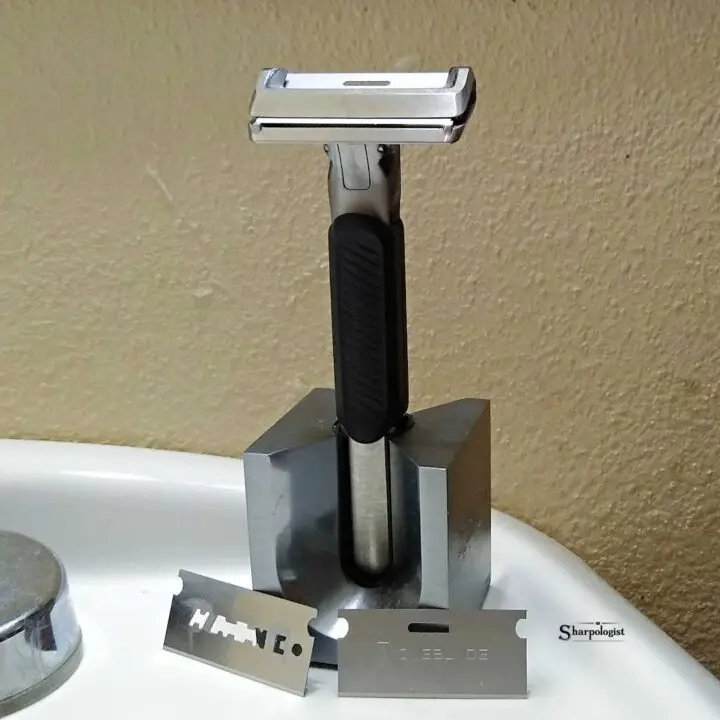
The Genesis model of the OneBlade razor line features a stainless steel head, a single “simple” blade on a skin-following pivot, and are known for their mild shave. OneBlade does offer razors made with different materials but the Genesis is the most biocompatible.
Proof Razor
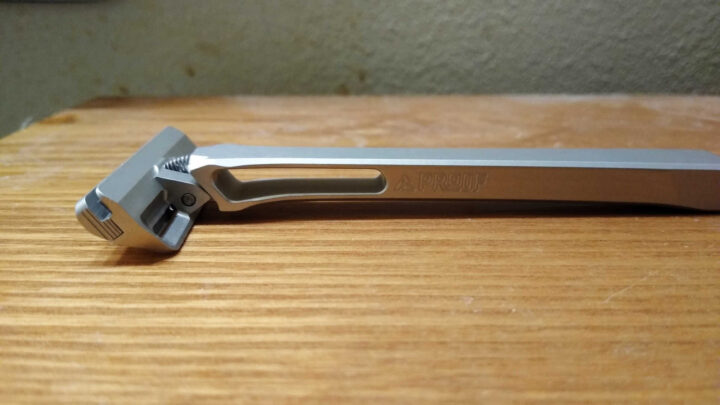
While not made with a more biocompatible material, the Proof razor is made from aluminum but offers many of the same features as the OneBlade razors (pivoting head, relatively mild shave), with one big advantage: it uses any brand of double edge razor blade (snapped-in-half or pre-cut). Click/tap here for Sharpologist’s full review.
Tatara Musamune
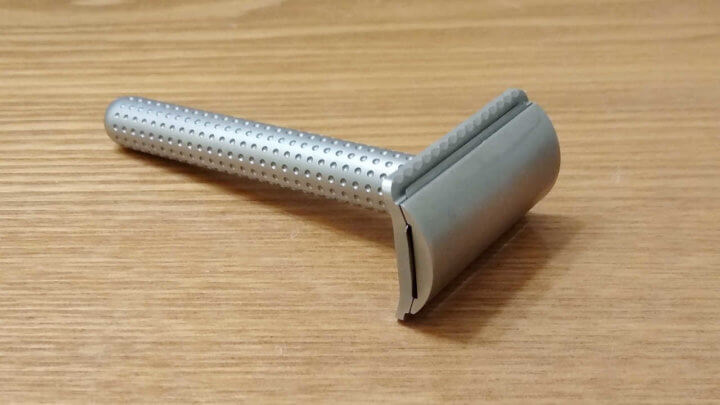
The Tatara Musamune is a stainless steel razor for double edge blades. Produced in Portugal, it is CNC machined in AISI 303 high grade stainless steel.
It is a three piece razor that offers an “open comb” option as well as closed-comb base plate. Both are considered “mild” on the skin (though the open comb is a little less so).
I find the Tatara Masamune razor to be excellent and suitable for beginner and experienced DE shaver alike. Click/tap here for my full review of the Tatara Masamune stainless steel double edge razor.
And Tatara recently introduced a titanium version of the Masamune (titanium is even more biocompatible than stainless steel). Click/tap here to read more about titanium razors.
Feather AS-D2
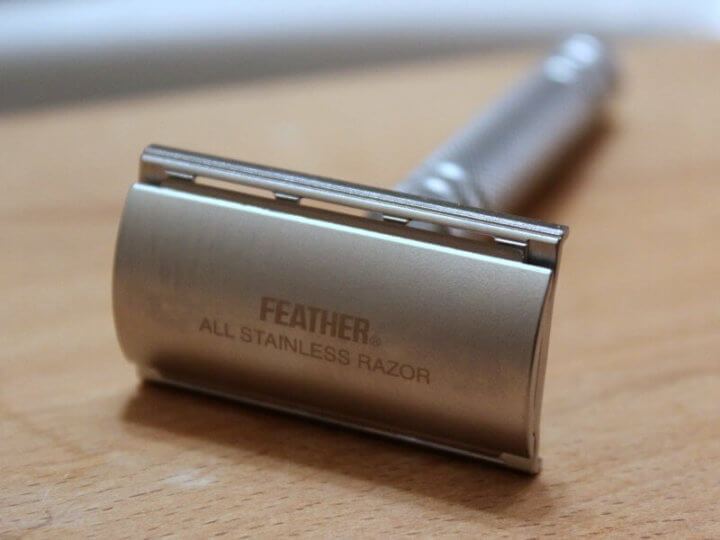
The Feather AS-D2 double edge razor is well-designed and well-built but has a reputation as being very mild. You may want to use a high performance “double edge” blade for best results.
The Feather All Stainless is in its second generation now (that’s where the “D2” comes from). You may find a range of prices for the AS-D2 set. This is partly because there are slight variations in the “kit”–some include a custom stand or a special gift package for example. You can find the razor alone for less but be sure you’re comparing apples-to-apples when shopping.
Click/tap here for a full discussion of the AS-D2.
Rockwell 6S
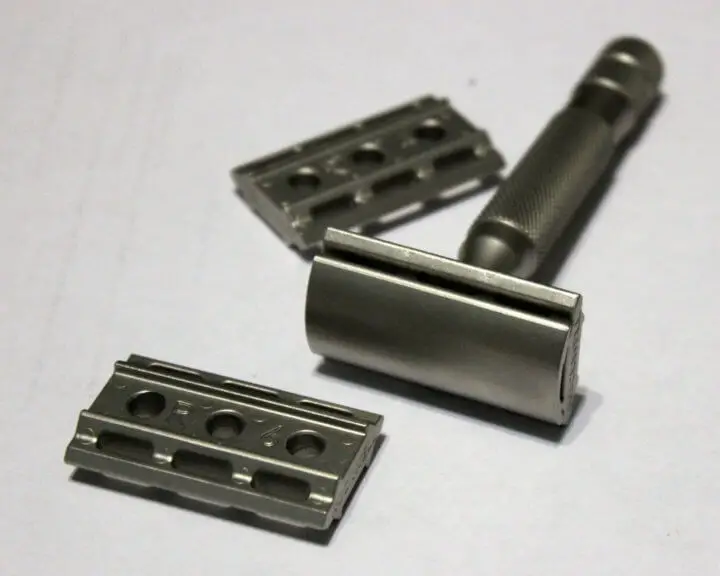
The Rockwell 6S single blade, double edge safety razor is made from Stainless Steel. It features a set of three “flippable” base plates to provide six different levels of shave aggressiveness.
Rockwell T2 Adjustable Razor In Stainless Steel
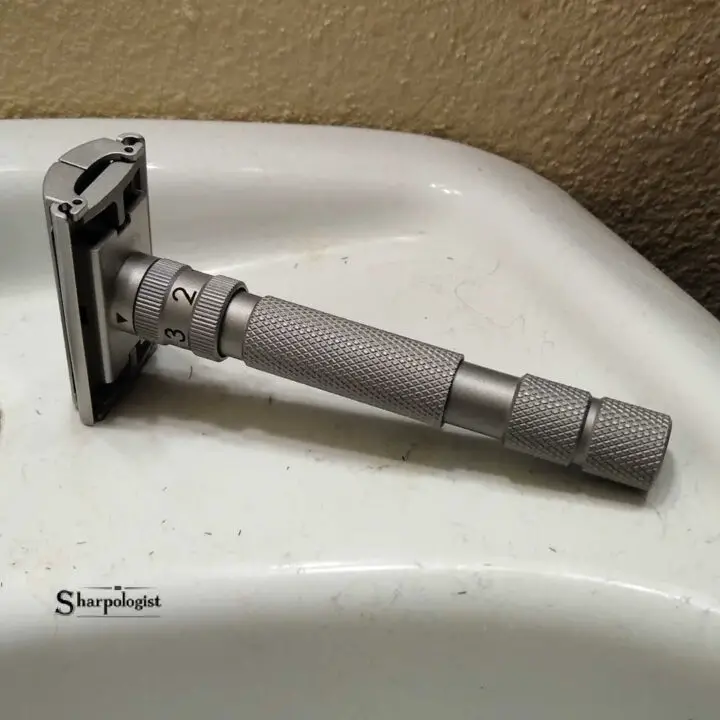
Rockwell also makes a fully-adjustable razor (no base plates to swap out), the T2. The T2 is offered in a stainless steel version which makes it more biocompatible to those with sensitive skin.
Click/tap here for Sharpologist’s full review of the T2 in stainless steel.
Karve Christopher Bradley

The Karve “Christopher Bradley” single blade, double edge safety razor is available in a number of materials including biocompatible stainless steel, copper, and brass.
The razor takes it’s inspiration from a number of different directions. It is following the recent trend of some single blade razor manufacturers like Rockwell by offering different base plates that provide an “adjustable” or “customizable” blade gap. That lets the shaver tailor the razor more closely to their specific shave desires and circumstances.
Click/tap here for my review of the Christopher Bradley (Brass)
Gillette SkinGuard Cartridge Razor

For something less expensive and more widely available, consider the Gillette SkinGuard. While it is not made with biocompatible materials and does have a lubrication strip it is specifically designed for those with sensitive skin.
The Gillette SkinGuard cartridge works on any handle that accepts Fusion cartridges, so if you have a Fusion handle laying around, you’re good to go. If you don’t have a Fusion handle you can get the SkinGuard with a handle (but it’s not a “FlexBall” handle).
Click/tap here for my full discussion of the Gillette SkinGuard.
But…are you sure the reaction is from your razor?
There are a lot of variables when it comes to the cause of “sensitive skin” from shaving. Are you sure the reaction is from your razor? It might be:
- Face washing soap
- Pre-shave oil or gel
- Shave cream or soap
- Aftershave
Or some other product in your shave routine.
But let’s say you’ve eliminated those possibilities and it’s narrowed down to the razor. But what is it, specifically, about the razor? There’s:
- Razor handle/head material (plastic, Zamak/alloy, stainless steel, etc.). Razor metals less likely to cause a skin reaction (more biocompatible) include stainless steel, titanium, and copper;
- Blade edge material (usually a form of stainless steel, though carbon steel is available);
- Blade edge coating (platinum, tungsten, chromium, various “non-stick” coatings);
- Lubrication strips or reservoirs;
- The number of blades mounted in the head/cartridge and the angle they are set to;
- Other design aspects of blade edge exposure to the skin.
Then there’s razor/shaving technique: you simply might be over-shaving the area.
Wait. Just What Is “Sensitive Skin?”
Sensitive skin is a condition where the skin is more prone to reacting to the environment. It can be the result of genetics and lifestyle choices and it can be aggravated by external factors, such as harsh chemicals, exposure to certain metals, or the sun.
The term “sensitive skin” is often used to describe skin that is easily irritated. This can manifest as itching, burning, pain, redness and swelling after topical use of products. It’s important to know that not everyone experiences these symptoms and they can vary in intensity from person to person.
Unfortunately, there is no official test or diagnosis for “sensitive skin”–it’s generally based on a person’s self-reported symptoms.
Therefore, you may hear people use the adjective “sensitive” rather than the medical term “sensitive skin.” In any case, if you’re experiencing any unpleasant sensations after using a product on your skin, it’s best to consult a dermatologist for advice.
The face is more prone to having sensitive skin due to its thinner, more delicate skin. Additionally, the condition may be an ongoing one that worsens over time or gets worse with certain treatments.
Clinical Features
While “sensitive skin” is largely an unofficial diagnosis, there are a number of different causes that create the symptoms that are generally described. Let’s dive a little more into it.
Sensitivities vs. Allergies vs. Intolerances
Sensitivities are neither intolerances nor allergies.
Intolerance usually applies to food, not grooming products, and involves the absence of an internal chemical that is necessary to digest or absorb a given food constituent. An example would be lactose intolerance.
Allergies involve a specific type of immune reaction. These reactions only occur after a second exposure to a given triggering chemical (or food). In the first exposure, the perceived-as-harmful substance (called an antigen) triggers the immune system to begin producing antigen-specific antibodies that will, upon later exposure, facilitate a cascade of immune processes, which usually result in symptoms.
Allergic reactions occur rapidly after exposure to the trig, usually within an hour or so ( sometimes longer) though often immediately.
Sensitivity reactions can manifest more slowly in time windows ranging from immediately (for some localized skin reactions) to up to 72 hours (for more systemic reactions). Another key difference between allergies and sensitivities is that an allergic reaction may be triggered by a very small amount of the allergen (such as in people with peanut allergies, who may have a life-threatening reaction to consuming a non-peanut food that is merely processed in the same facility as peanuts).
Sensitivities are usually dosage dependent. The greater the exposure, the more likely there will be a sensitivity reaction and the stronger it will likely be. There is often also a reaction threshold in sensitivity reactions, below which there will be no symptoms.
For a more thorough understanding of the differences click/tap here to read Is Shaving Making You Sick? Sensitivities to Grooming Products
Causes Of Sensitive Skin
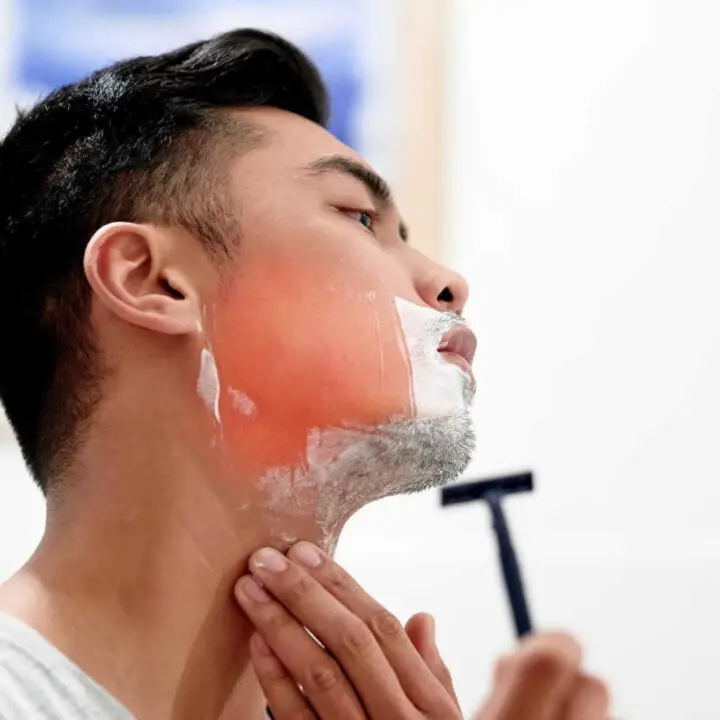
There are a number of conditions that can result in skin sensitivity. The most relevant to this discussion are:
Irritant Contact Dermatitis (ICD)
ICD is the most common cause of sensitive skin. It is the result of a reaction to a substance which is normally tolerated on the skin but which causes a reaction when applied to the skin.
The most common irritant contact dermatitis is contact dermatitis from detergents and soaps. Frequent washing of the skin can lead to dry skin and increased sensitivity to detergents.
Allergic Contact Dermatitis (ACD)
ACD is characterized by an acute inflammatory reaction to contact with a chemical, and is often preceded by a non-specific or vague skin reaction. The most common site of reaction is the face.
There are four different forms of ACD. One ACD is Physical Urticaria, characterized by wheals (an area of the skin which is temporarily raised, typically reddened, and usually accompanied by itching) that develop on the skin following physical (mechanical) irritation (like shaving!).
Dermographism
This is usually a reaction to something that the person had handled and then scratched. As the person scratches he or she will feel intense pricking, stinging, burning or tingling sensation. When the person stops scratching, the rash disappears and the skin is dry.
How Is Sensitive Skin Diagnosed?
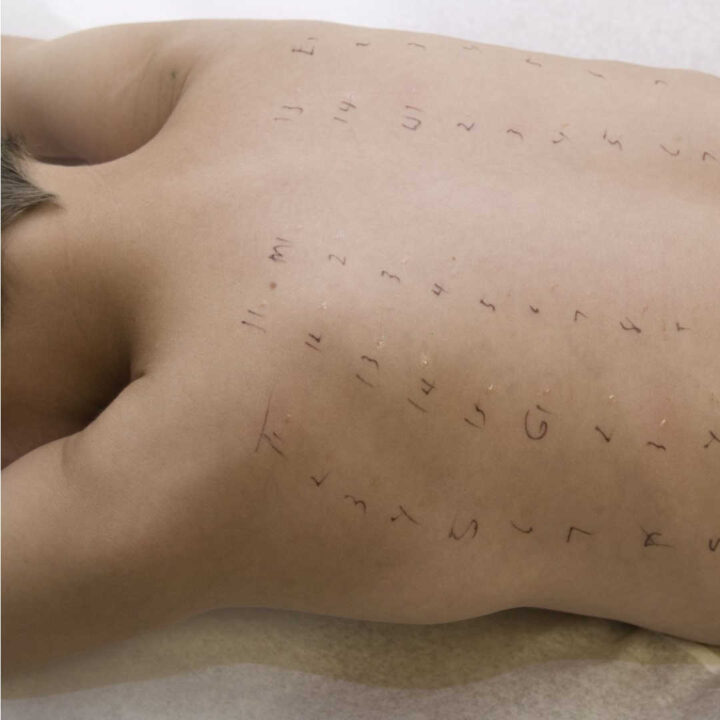
A dermatologist usually diagnoses skin sensitivity by a clear history, noting the type of product that causes dermatitis, the time it takes for the reaction to develop, the symptoms on the skin and whether the person is sensitive to certain foods or drinks for example.
The dermatologist may also perform a patch test A patch test is the application of a substance to the skin and then a follow-up visit to see if there is a reaction. This is especially useful for people who have an allergy to something they are using or wearing.
Best Safety Razor Blades For Sensitive Skin
There is no one-size-fits-all answer to this question, as the best safety razor blades for sensitive skin will vary depending on a user’s individual skin type; the blade’s metallurgy, coatings, and grinding specifications can play a part too.
Some shaving vendors sell “sample packs” or “blade samplers” to make the process easier: you get a few blades of many different types. After you decide which one(s) work best you can then buy your favorites in bulk.
Take the time to experiment with a number of different blade brands to find the one(s) that work best for the razor you’re using and your skin.
Shave Technique
Shaving “efficiently”–that is, without over-shaving–can help deal with sensitive skin.
Shaving “against the grain” can cause irritation and razor burn, and can lead to ingrown hairs and razor bumps.
Think twice about shaving against the grain if you are a man-of-color, have very curly hair, are predisposed to ingrown hairs, or have sensitive skin.
Click/tap here to learn all about properly shaving according to the stubble’s “grain.”
Summing Up
In conclusion, the best razor for sensitive skin is the one that has fewer blades and a skin-friendly design. This is because the more blades there are, the more likely it is that your skin will get irritated. Being knowledgeable about blades and shaving technique will help, too!

Thank you for this detailed article. It appears that experience and consistent DE razor shaving over time allows the skin get used to the shaves thus gradually reducing the chances of skin irritation. From my experience, probably due to lack of consistent shaving skills, I always had a lot of irritation post shave that would last for 1-2 days, but recently, after over a year of developing skills and techniques, I do regular 3-pass shaves and hardly get irritations again. My current razors are the Rockwell 6C and Parker 78R; both excellent razors that I enjoy using on my face and head.
Thanks for the insightful article – a good reference point here Mantic!
I was surprised, though, not to see the Rex Ambassador or the Henson AL13 on the list. Both of which have a considerably mild blade gap that works exceptionally well for those with sensitive skin (or shaving sensitive areas of the body).
Furthermore, for value especially compared to the adjustable 6S, the Rex Ambassador doesn’t require you to do the cumbersome swapping of baseplates, making it a more seamless experience overall. And the Henson AL13, being made from aluminum, is not only lightweight but also less likely to cause any allergic reactions, making it a great choice for sensitive skin too.
Lastly, I wholeheartedly agree with your point on shaving technique. It’s crucial to be mindful of our shaving habits to avoid over-shaving or shaving against the grain, which could lead to skin irritation, especially for those with sensitive skin.
Thanks for providing such a comprehensive guide. It will be of great help to many! Cheers!
Thanks for your comments. I agree with you that the Henson AL13 is an excellent mild razor but aluminum is not an allergic-friendly metal (I talk about reactive metals in the article). The Henson Ti-22 razor, made out of titanium, may be a better choice and one I may add when I do my regular update of this article. I like the Rex Ambassador too and also might include it in an update article.
Ah my mistake on oversight re: aluminum. Was just giving this a further read and saw that the AAD named aluminum the allergen of the year for 2022 (https://www.aad.org/dw/dw-insights-and-inquiries/archive/2022/aluminum-allergen-of-the-year-2022) 🤦♂️!
Considering my own skin sensitivity, I’ve used several of the suggested razors and am surprised that you’ve omitted the Razorock Mamba and BBS razors. The original Mamba with its negative blade exposure is arguably the mildest DE razor I’ve used. Milder, I would say, than the Feather AS-D2. The BBS is more efficient but still quite mild, especially with the original base plate.
I’ll consider adding the Mamba in a future update. I thought the Mamba’s head design makes blade changing a bit fussier, and the blade angle “sweet spot” a bit narrower, than other razors.
Blade changing is a bit different from most razors, with the blade loading onto the base plate, but once I quickly adapted to it, I found it quite easy. And yes, the sweet spot is narrower than most razors. I consider it slightly narrower than the AS-D2’s, but it’s quite manageable using short strokes. I would not recommend the Mamba for heavy beards, but for truly sensitive skin it can be a godsend.